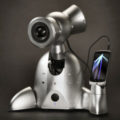
Engineers at the University of Washington (UW) have for the first time used microscopic manufacturing techniques to combine a flexible, biologically safe contact lens with an imprinted electronic circuit and lights. “Looking through a completed lens, you would see what the display is generating superimposed on the world outside. People may find all sorts of applications for it that we have not thought about. Our goal is to demonstrate the basic technology and make sure it works and that it’s safe,” said Babak Parviz, who heads a multi-disciplinary UW group that is developing electronics for contact lenses.
The results were presented this week at the Institute of Electrical and Electronics Engineers’ international conference on Micro Electro Mechanical Systems by Harvey Ho, a former graduate student of Parviz’s now working at Sandia National Laboratories in Livermore, California.
The prototype device contains an electric circuit as well as red light-emitting diodes for a display, though it does not yet light up. The lenses were tested on rabbits for up to 20 minutes and the animals showed no adverse effects. Parviz says that installing or removing the bionic eye would be as easy as popping a contact lens in or out, and once installed the wearer would barely know the gadget was there.
Parviz stressed that all the electronic gadgetry wouldn’t obstruct a person’s view. “There is a large area outside of the transparent part of the eye that we can use for placing instrumentation,” Parviz said. Future improvements will add wireless communication to and from the lens. The researchers hope to power the whole system using a combination of radio-frequency power and solar cells placed on the lens. A full-fledged display won’t be available for a while, but a version that has a basic display with just a few pixels could be operational “fairly quickly,” according to Parviz.
Related:
Bionics: The Six Million Dollar Question
Technology Makes ‘Super’ Human Vision Possible
Eye Of The Beholder Redux









Comments are closed.